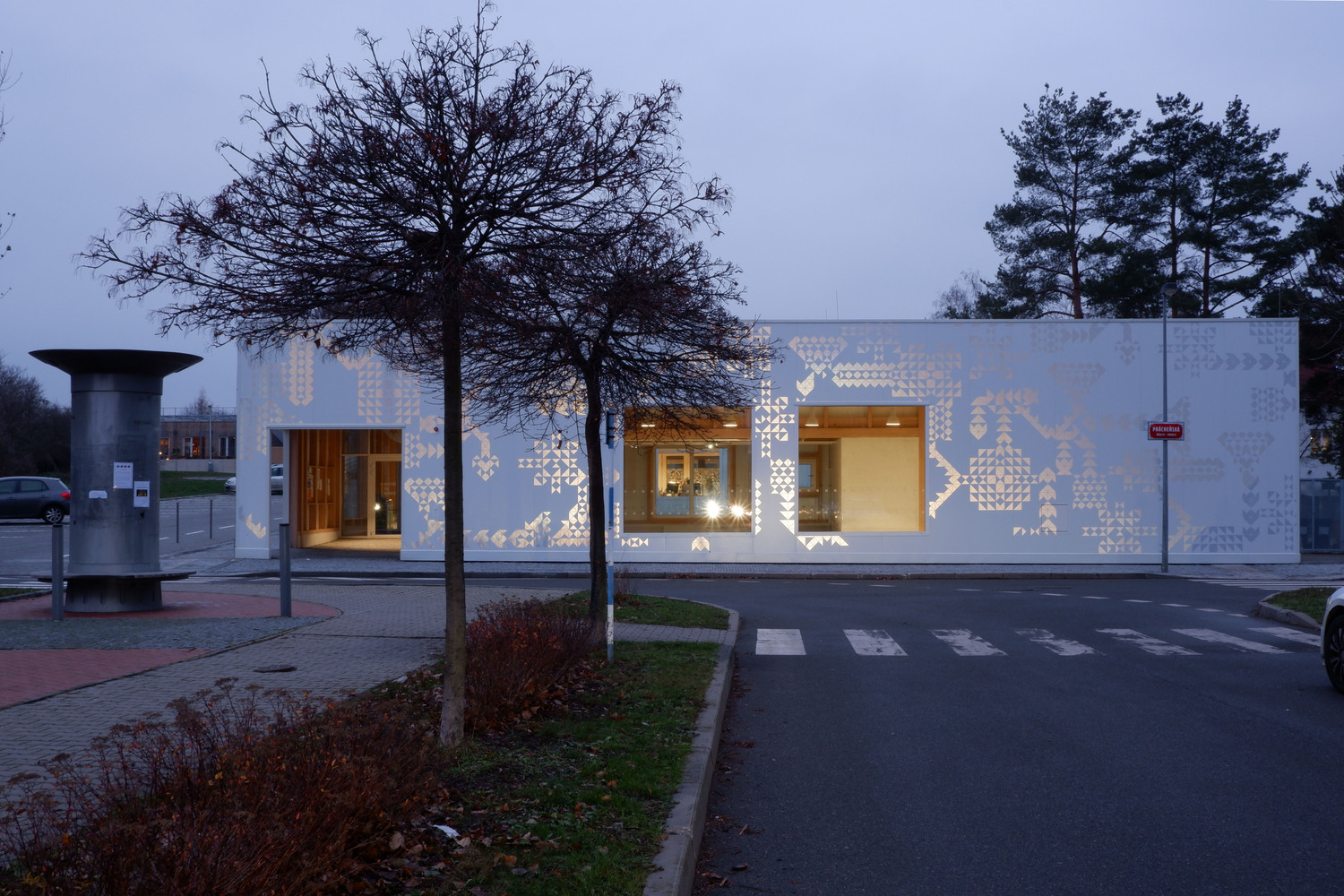Film Theatre of Catalonia Mateo Arquitectura
2014-03-09 01:00
© Adrià Goula
(AdriàGoula)


1.根据建筑师的说法,菲尔莫特卡(Filmoteca)
1. The Filmoteca according to its architect
<关于表格.废墟标志着建筑物的结构。罗马论坛将地基和排水平面正规化。在旧城,我的建筑开始用纯粹的结构来表达自己-没有包层,也没有装饰。形成外墙的光秃秃的混凝土梁和墙是非常不同的,这证明了他们是邻墙的家庭成员,那里的灰泥碎屑显示了他们最初的中心质量。滤镜贴在墙上。这个电影隐喻不仅仅是概念性的,它最重要的是物理上的,理智的。在旧城,由于建筑物之间的关系非常密切,相互作用必须经过调解、过滤。这是通过各种设备实现的,带有模糊的电影参考资料。
<< About the form... The ruins mark the structure of the buildings. The Roman forum formalizes the plane of foundations and drains. In the old town, my building sets out to express itself as pure structure—no cladding, no finishes. The bare concrete beams-cum-walls that form the façades are very varied, proving themselves members of the family of the dilapidated neighbouring walls, where plaster crumbles to reveal their original central mass. Filters are juxtaposed on the wall. This cinematographic metaphor is not just conceptual; it is above all physical, sensible. In the old town, with very close relations between buildings, interaction must be mediated, filtered. And this is implemented by a variety of devices, with a vague cinematographic reference.
© Adrià Goula
(AdriàGoula)


关于太空.。这个空间是围绕着两个运动组织起来的:
About the space... The space is organized around two movements:
(A)电影院陷入黑暗,观众的倒影(反过来,演员在一系列镜子中看到)
a) The descent into the darkness of the cinemas, with the reflection of the spectators (in turn reflected, actors seen in a series of mirrors)
(B)朝向光明、工作地点的上升。
b) The ascent towards the light, towards the places of work.
两个连接但不连续的庭院,伴随和构造运动。
Two courtyards, connected but not continuous, accompany and construct the movement. >>
2-加泰罗尼亚电影剧院的奇点
2-The singularity of the Film Theatre of Catalonia


A-那个地方
A- THE PLACE
加泰罗尼亚电影剧院位于巴塞罗那的埃尔拉瓦尔市。近几年来,这一地区虽然保留了一个港口地区的流行、建设甚至压迫的传统,但却陷入了一个重大的转型和现代化进程中。
The Film Theatre of Catalonia is situated in the his- toric neighbourhood of El Raval, in Barcelona. In recent years this area has been immersed in a major process of transformation and modernization though it retains the popular, built-up, even oppressive na- ture of a port district.
© Adrià Goula
(AdriàGoula)


Filmoteca反映了其存在的矛盾心理。它处理过去的结构,而不隐瞒其存在的力量。
The Filmoteca reflects the ambivalence of its exis- tence. It addresses the structures of the past without concealing the force of its presence.


它与环境的关系是确定建筑物体积的决定性因素。该项目具有规模,允许购买与邻近建筑正式相关,并促使决定地下电影院。一楼是为影剧院的使用者设计的通道,将一边的街道与另一边的广场连接起来。位于大楼前面的萨尔瓦多广场是一个新的空间,为该地区引入了光和空气。
Its relation with the setting was determinant in defining the volume of the building. The project works with scale, allowing the buil- ding to relate formally with neighbouring constructions and prompting the decision to underground the cinemas. The ground floor is designed as a passageway for users of the film theatre, connecting the street on one side to the plaza on the other. The Plaça de Salvador Seguí, in front of the building, is a new space that introduces light and air into the area.
© Adrià Goula
(AdriàGoula)


这座建筑压缩了狭窄而复杂的现有建筑,作为一个对立面,侧立面创造了一个新的亲密空间:一系列由投影保护的门廊。
The building compresses the narrow, complex existing structures and, as a counterpoint, the side façades create a new and intimate space: a series of porches protected by projections.
© Adrià Goula
(AdriàGoula)


A-结构
A- THE STRUCTURE
结构布局是围绕着两卷长方形平面图的空间组织的产物。一层是一层,另一层是广场上方。
The structural layout is the product of the organization of space around two volumes with rectangular floor plans. One is capped at ground floor level and the other rise up above the plaza.
© Adrià Goula
(AdriàGoula)


纵向的立面限制了上一级的体积,而最终的立面折叠在自身上,产生了一系列突出的体积。
The longitudinal façades confine the above-grade volume, whereas the end façades fold over themselves, producing a series of projecting volumes.
由于各种原因,建筑物的功能要求和空间概念排除了在底盘量中使用中间体的可能性:
The functional requirements and spatial conception of the building rule out the use of intermediates supports in the undergrounded volume, for various reasons:
-这卷书容纳了电影院,需要大面积的空间,没有柱子或结构墙
- This volume houses the cinemas, calling for large spaces without pillars or structural walls
© Adrià Goula
(AdriàGoula)


-地面上的体积会产生一系列的透光装置,使建筑物内的光线变亮。
- The volume above ground creates a series of transparencies that draw light inside the building.
。这种结构是由两个与两个外纵墙对应的平面产生的。低于等级的部分被给予更传统的处理,因为它们是挡土墙,而上面出现的部分是由它们所形成的空间的要求“雕刻”的。
. The structure is generated by two planes that correspond to the two outer longitudinal walls. The parts of the walls below grade are given a more conventional treatment, as they are retaining walls, whereas the parts that emerge above are “sculpted” by the demands of the spaces they form.


这个结构组织了整个建筑:主要的外墙是两面屏风墙,将地面和第二层的柱子分开,因为每一层都是由金属纽带悬挂在上面的地板上。最后的墙壁是悬臂,以创造更多的空间,在街道上,他们划定。
The structure organizes the whole building: the main façades are two screen walls that free up the ground and second floors of pillars, as each is suspended from the floor above by metal ties. The end walls are cantilevered to create more space in the streets they delimit.
每对墙之间都有排列的横梁,这些横梁经过后张,以减小它们的深度。这些梁也支持传统的实心楼板地板.
Between each pair of walls are ranged cross beams that have been post-tensioned to reduce their depth. These beams also sup- port conventional solid slab floors.
© Adrià Goula
(AdriàGoula)


3引导访问
3-Guided Visit
覆盖普拉萨·德萨尔瓦多·塞古伊的玄武岩以葡萄牙人行道的风格排列,进入电影院的门厅,将外部与内部连接起来。宽敞的门厅是通过全景洞口照亮的,这些洞口构成了城市景观的框架,就像CinemaScope屏幕一样。Filmoteca是设计成一系列的过滤器和屏幕定位在外观之间,中间的内部和外部,横向和自上而下。
The basalt stone covering Plaça de Salvador Seguí, arranged in the style of Portuguese pavements, makes its way into the foyer of the film theatre, connecting the exterior with the inside. The spacious foyer is lit via panoramic openings that frame the immediate urban landscape, like CinemaScope screens. The Filmoteca is designed as a series of filters and screens positioned in the façades that mediate between inside and out, laterally and top to bottom.
-1 Basement
-1 地下室


下到地下室一楼,我们找到了临时展览厅和研讨会室。一直到地下二楼,我们来到了两家电影院。下降到地下地板的特点是黑暗,镜子,玻璃和浅色表面引入光。
Descending to the first basement floor we find the temporary exhibition gallery and seminar rooms. Continuing down to the second basement, we come to the two cinemas. The descent to the underground floors is characterized by darkness, into which mirrors, glass and light-coloured surfaces introduce light.
© Adrià Goula
(AdriàGoula)


该建筑被设想为一系列过滤器和屏幕,外部和内部。它与外部的关系是由一系列由金属丝和穿孔金属片组成的图案来调节的,这些图案可以过滤日光,给居住者隐私,让他们看上去不被人看见。在内部,滤镜的使用继续在上层;彩色玻璃屏幕隔开空间,并像滤镜和隔膜一样,控制自然光的强度和颜色。
The building is envisaged as a series of filters and screens, exterior as well as interior. Its relation with the exterior is mediated by a series of patterns made of wire and perforated metal sheet that filter daylight and give the occupants privacy, allowing them to look without being seen. Inside, the use of filters continues on the upper floors; coloured glass screens divide the space and, like the filters and diaphragms used in film cameras, control the intensity and the colour of natural light.




























































Architects Mateo Arquitectura
Location Catalonia, Spain
Category Public Architecture
Architect in Charge Josep Lluís Mateo
Area 7515.0 m2
Project Year 2011
Photographs Adrià Goula
Manufacturers Loading...
























